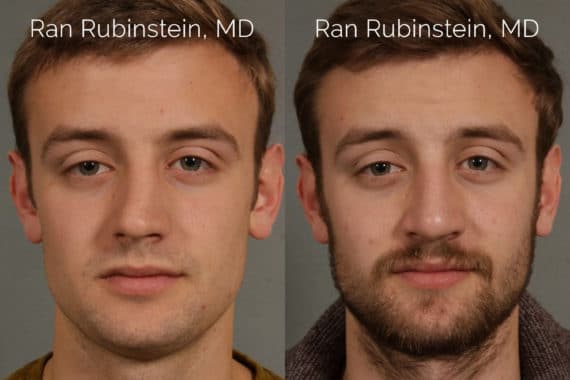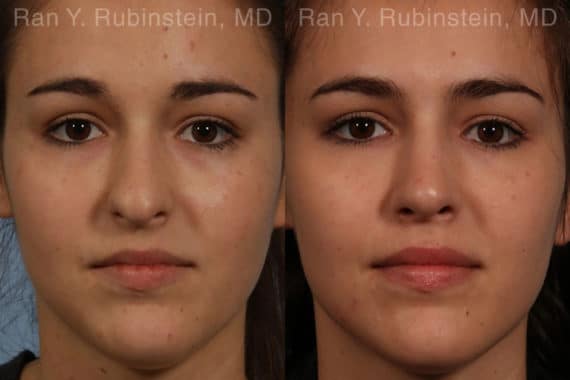Cosmetic rhinoplasty, often combined with functional rhinoplasty, can enhance both the appearance and functionality of the nose. Understanding the recovery process is essential to set realistic expectations and ensure a smooth healing journey. Here’s a detailed week-by-week guide to help patients navigate their rhinoplasty recovery, whether the procedure is cosmetic, functional, or a combination of both.

Essential Insights for Cosmetic and Functional Rhinoplasty Recovery
- Recovery from cosmetic rhinoplasty and functional rhinoplasty is a gradual process that requires patience.
- A week-by-week guide provides insights into the healing process and when patients can resume normal activities.
- Dr. Ran Rubinstein, a double board-certified facial plastic surgeon, offers personalized care to ensure optimal recovery.
What is Cosmetic Rhinoplasty vs. Functional Rhinoplasty and Why Does Recovery Matter?

Cosmetic rhinoplasty is a surgical procedure that reshapes the nose to improve its appearance. It is often combined with functional rhinoplasty, which corrects structural nasal issues such as a deviated septum or nasal valve collapse to enhance breathing. Recovery is critical because:
- Proper healing ensures long-term success.
- Following recovery tips minimizes complications.
- It allows for the full benefits of the procedure to take shape.
Start Your Journey to a New Look and Better Breathing. Don’t Wait More!
Join our satisfied clients who’ve experienced safe, effective surgeries.
Week-by-Week Recovery Timeline
Week 1: Rest and Initial Healing
The first week is dedicated to rest and the initial stages of healing. Here’s what to expect:
- Splints and Bandages: Splints are placed to support the nose during the healing process. These are typically removed at the end of the first week. A drip pad bandage is applied beneath the nose to absorb any drainage during the first 24-48 hours. This bandage is changed as needed and is usually not necessary beyond 24-48 hours.
- Swelling and Bruising: Expect swelling around the eyes and nose, which is normal and will subside gradually.
- Breathing Difficulty: Nasal congestion is common due to swelling.
- Care Instructions:
- Avoid any physical activity
- Use a cool mist humidifier to help keep nasal passages moist and comfortable
- Avoid blowing your nose and sneeze with your mouth open
- Keep your head elevated to reduce swelling.
- Follow Dr. Rubinstein’s aftercare guidelines.
Key Milestone: Splint removal and the first follow-up visit with your rhinoplasty surgeon.
Week 2: Reduced Swelling and Gradual Comfort
By the second week, many patients notice improvements:
- Swelling Reduction: Swelling starts to decrease, making the nose look less puffy.
- Breathing: Some patients begin to experience easier breathing as internal swelling subsides, though improved breathing may take up to 6 weeks.
- Activity Level:
- Light activities like walking are encouraged.
- Avoid heavy lifting or bending over, which can increase blood flow to the face.
Weeks 3–4: Returning to Normal Activities
During this period, most patients feel more like themselves and can gradually return to their routines:
- Appearance: Bruising and swelling are significantly reduced, and the nose begins to take on its new shape.
- Physical Activity:
- Resume moderate activities but still avoid strenuous exercises.
- Swimming and contact sports should be postponed.
- Social Confidence: Many patients feel confident resuming social and work engagements.
- Recovery Tips: Use sunscreen on your nose to protect it from UV rays and support healing.
Months 1–3: Long-Term Results Taking Shape
- Nasal Functionality: Breathing continues to improve as internal swelling resolves.
- Final Appearance: While subtle refinements may continue for up to a year, most changes become apparent within this timeframe.
- Return to Activities: Strenuous activities, including sports, can typically be resumed with your surgeon’s approval.
Key Milestone: Follow-up appointments to monitor healing and ensure optimal results.
Patient Results
* All patients are unique and individual results may vary.
The Role of an Expert Surgeon for Cosmetic and Functional Surgery
Cosmetic and functional rhinoplasty and nasal surgery require a skilled, board-certified facial plastic surgeon. An experienced surgeon ensures:
- Precise surgical techniques to achieve aesthetic goals and correct structural issues.
- Minimal side effects and complications.
- A seamless blend of functional improvement and aesthetic refinement.
- Expertise in addressing complex cases, including revision rhinoplasty for previous nasal surgeries.
When to Seek Help During Cosmetic or Functional Rhinoplasty Recovery
While most side effects are normal, contact your surgeon immediately if you experience any of the following:
- Persistent or worsening pain.
- Excessive bleeding.
- High fever or signs of infection.
- Severe breathing difficulties.
Dr. Rubinstein is available to address any concerns promptly, ensuring your recovery stays on track.
Why Choose Dr. Ran Rubinstein?
Dr. Ran Rubinstein is a leading double board-certified facial plastic surgeon in Newburgh, NY, specializing in cosmetic and functional rhinoplasty. With decades of experience, Dr. Rubinstein provides:
- Personalized consultations to address each patient’s unique needs.
- State-of-the-art techniques for effective and natural results.
- Comprehensive pre-and post-operative care to optimize recovery.
- Expertise in head and neck surgery, ensuring safe and precise procedures.
Schedule a Consultation with Dr. Ran Rubinstein in Newburgh, NY
Ready to enhance your appearance and improve your breathing? Schedule a personalized consultation with Dr. Rubinstein today. Whether you’re considering cosmetic rhinoplasty, functional rhinoplasty, nasal surgery, or deviated septum surgery, Dr. Rubinstein and his team will guide you every step of the way. Call our office or schedule a consultation online today.


